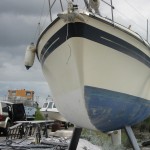Yacht Antifoul Removal
Abercorn provide several other antifoul removal systems including slurry blasting and abrasive blasting as well as soda blasting. Each method has its strengths and budgets more information on antifoul removal, please visit www.antifoulblasting.co.uk
Antifoul removal from the bottom of a boat by Soda Blasting is a win-win for both boatyard, yacht and boat owners. For the work to be carried out and completed within the marina compound, Soda Blasting is faster, cleaner, less expensive and environmentally friendly.
Soda Blasting Boats is also environmentally friendly, a major concern for repair yards and marinas. Minimal plastic tenting

Antifoul Removal
installed around the work area contains the soda and old paint for proper disposal.
The actual Soda Blasting step only takes a few hours and, depending on the size of the boat, the entire process can be completed in a day or less.
All This and Environmentally Freindly Too How do they do That!
“The environmental friendliness of the Soda Blaster, its ability to safely and accurately remove many layers of old anti-fouling coating and the speed in which even large jobs are accomplished make the Soda-Blaster from Soda Blast Scotland invaluable.”
Yacht owners can rest easier these days, now that Soda Blast Scotland are able to provide their environmentally friendlier anti-fouling service across an increasing number of marinas.
By using Soda Blast Scotland a 35ft yacht with a 9ft beam can be strip and ready for painting in under 4hours.
Soda Blast Scotland out perform alternative methods due to the inherent properties of the Soda and the delivery system used by the Soda Blaster.
Treating and removing boat blisters
When the bottom of the hull is camouflaged with multiple layers of paint and marine growth, a less labour-intensive approach is needed. Unlike sanding or corrosive chemicals, Soda Blasting boats removes old coats of antifoulant and blisters quickly, without damaging non-blistered, bare gelcoat, and then properly prepares the surface for repair—all in one operation.
Blisters are most often caused by osmotic intrusion of water into the hull. As water molecules enter the hull, they pick up acids and other chemicals that alter their composition and size, making the molecules larger and trapping them inside. Since these molecules are unable to find their way out, pressure builds up and forces the gelcoat to separate from the fiberglass, forming a blister. If the blister breaks while immersed, it allows for greater water intrusion into the fiberglass laminate, and perpetrates the blistering process to deeper levels.
Traditional blister repair involves grinding, sanding or sandblasting the hull. This process is time-consuming, labour intensive and, unless extreme care is taken, can result in severe or permanent damage to the gelcoat and fiberglass laminate.
Soda Blast Scotland, provides a fast, effective and controlled alternative to these conventional methods.
In the Soda Blasting process, a non-destructive stream of specially formulated baking soda is delivered under high pressure is used to strip the antifoulant paint and open the blister. Then, to prepare the surface for repair and repainting, the affected area around the blister is feathered by split-second, swirled “micro-blasting.” This finishes the surface in preparation for repair. The entire process can be accomplished in 1/10 the time as traditional techniques, resulting in a properly prepared surface that is ready for blister repair and painting.
Soda Blasting Boats is also environmentally friendly, a major concern for repair yards and marinas. Minimal plastic tenting installed around the work area contains the soda and old paint for proper disposal.